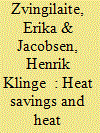| Srl | Item |
| 1 |
ID:
137681


|
|
|
|
|
| Summary/Abstract |
The trade-off between investing in energy savings and investing in individual heating technologies with high investment and low variable costs in single family houses is modelled for a number of building and consumer categories in Denmark. For each group the private economic cost of providing heating comfort is minimised. The private solution may deviate from the socio-economical optimal solution and we suggest changes to policy to incentivise the individuals to make choices more in line with the socio-economic optimal mix of energy savings and technologies.The households can combine their primary heating source with secondary heating e.g. a woodstove. This choice results in increased indoor air pollution with fine particles causing health effects. We integrate health cost due to use of woodstoves into household optimisation of heating expenditures.The results show that due to a combination of low costs of primary fuel and low environmental performance of woodstoves today, included health costs lead to decreased use of secondary heating. Overall the interdependence of heat generation technology- and heat saving-choice is significant. The total optimal level of heat savings for private consumers decrease by 66% when all have the option to shift to the technology with lowest variable costs.
|
|
|
|
|
|
|
|
|
|
|
|
|
|
|
|
| 2 |
ID:
096651


|
|
|
|
|
| Publication |
2010.
|
| Summary/Abstract |
The increasing prevalence of renewable and intermittent energy sources in the electricity system is creating new challenges for the interaction of the system. In Denmark, high renewable shares have been achieved without great difficulty, mainly due to the flexibility of the nearby Nordic hydro-power dominated system. Further increases in the share of renewable energy sources require that additional options are considered to facilitate integration with the lowest possible cost.
With large shares of intermittent energy, the impact can be observed on wholesale prices, giving both lower prices and higher volatility. A lack of wind that causes high prices is rarely seen because long periods without wind are uncommon. Therefore we focus on the low price effects and the increased value of flexible demand options. On the supply side, there is an increase in the value of other flexible generation technologies and the attractiveness of additional interconnection capacity. This paper also analyses options for increasing the flexibility of heat generation involving large and decentralized CHP plants and heat generation based on electricity. The incentives that the market provides for shifting demand and using electricity for heat production are discussed based on the variability of prices observed from 2006 to 2008.
|
|
|
|
|
|
|
|
|
|
|
|
|
|
|
|
| 3 |
ID:
097487


|
|
|
|
|
| Publication |
2010.
|
| Summary/Abstract |
The increasing prevalence of renewable and intermittent energy sources in the electricity system is creating new challenges for the interaction of the system. In Denmark, high renewable shares have been achieved without great difficulty, mainly due to the flexibility of the nearby Nordic hydro-power dominated system. Further increases in the share of renewable energy sources require that additional options are considered to facilitate integration with the lowest possible cost.
With large shares of intermittent energy, the impact can be observed on wholesale prices, giving both lower prices and higher volatility. A lack of wind that causes high prices is rarely seen because long periods without wind are uncommon. Therefore we focus on the low price effects and the increased value of flexible demand options. On the supply side, there is an increase in the value of other flexible generation technologies and the attractiveness of additional interconnection capacity. This paper also analyses options for increasing the flexibility of heat generation involving large and decentralized CHP plants and heat generation based on electricity. The incentives that the market provides for shifting demand and using electricity for heat production are discussed based on the variability of prices observed from 2006 to 2008.
|
|
|
|
|
|
|
|
|
|
|
|
|
|
|
|